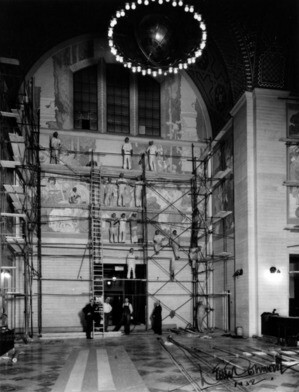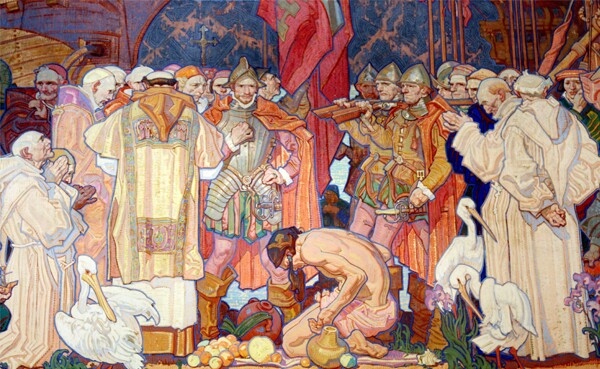Central Library Murals Are Also 80 Years Old


The rotunda of the Los Angeles Public Library Central Branch is an ornate entrance to the early cultural spirit of the city. The crown is a mosaic pyramid topping the interior dome, and the lobby wears a mural like a cloak.
The murals were a civic commission granted to Dean Cornwell that show "Four Great Eras of California History" in a series of four panels: "The Founding of Los Angeles", "The Discovery Era", "The Mission Era" and "The Americanization of California."
Known to be a five-year project, some documentation say the murals were completed in 1932. The date on the piece is 1933, and a call to the Central Library had a librarian quote from the LAPL publication, "The Light Of Learning," which said that 1933 was the year of completion date. So 1933 may not be a delayed dedication time stamp.
Whichever year the official completion date may be, it means the major work that has survived grime, two arson fires, and budget cuts, is not getting much attention on its 80th Anniversary.
"Four Great Eras of California History" won't get the majestic pilgrimage granted to David Alfaro Siqueiros' "América Tropical," which was rededicated in October of last year, 80 years to the day it was first presented to the public. At that opening, and now, the counter narrative of "América Tropical" upstages Cornwell's Central Library series of murals.
Cornwell may not have bristled with that idea at all. He may even have appreciated Siqueiros getting, and causing, all the thunder.

As a renowned New York illustrator for major magazines and advertising in the first years of the 20th Century -- and until his death in 1960 -- Cornwell took a sabbatical from his profitable commercial work in mid-career. He went to England in 1927 at age 35 to study under muralist Frank Brangwyn.
Brangwyn selected Cornwell to assist him in a series of murals, including one at the House of Lords.
"At the time, murals were a higher calling for artists" said curator Jeffrey Morseburg, who is gathering archival materials on Theodore Lukits, the painter who assisted Cornwell with the painting and composition of the library's murals. "The Los Angeles Public Library may be his first major commissions after [studying with] Brangwyn."
Another mural by Cornwell is in Redlands, at the Lincoln Memorial Shrine.

Cornwell projected images on to a large canvas before painting it with his oils -- a technique that may have influenced Siqueiros' own use of illuminating figures on walls. Also, as a visiting artist engaged with the California Art Club, and with a respect for the work of muralists, Cornwell was a supporter of Siqueiros' residency in Los Angeles. With F.K. Ferenz, the director of the Plaza Art Center, Cornwell sponsored Siqueiros' project at Olvera Street, and even said a few words at the dedication.
Cornwell was also one of the 29 artists who assisted in the painting of "America Tropical."
Using California to start another career within a career, and stepping away from what had brought him fame, Cornwell kept the interest of the New York art world. As for his murals, his work may be seen as an illustrator invading fine art. Cornwell was dutiful of his illustration mentor, Harvey Dunn, and carried the Brandywine tradition of carefully composed bold figures staged with theatrical color and composition.
The Cornwell paintings are oil on canvas, painted in a local scenic studio from sketches made in London and New York, wrote Los Angeles based art critic Arthur Millier in a 1932 article in the New York Times. "Within the limitation of Cornwell's style, they are superbly done. Red-orange and blue are dominant. Three hundred figures may be counted, each four times life-size. Indians, Spaniards, padres, gold-seekers -- all the colorful pageant of California's story -- are here." Yet, he referred them as decorations.

It was the craft of Cornwell's murals that was celebrated -- but not the content. Once awarded the commission, Cornwell, again with the help of Theodore Lukits, began to research California's history, said Morseburg. The mural's narrative was based on a civic history gleaned from published materials that celebrated the colonization of California.
When "América Tropical" was in a planning stage to be presented to the public by 1995, Los Angeles Times art critic Christopher Knight compared the two works. With a "palette of pinks, yellows, greens and blues," he wrote, "Cornwell told a peaceful fairy tale of California's founding by Christian Spanish settlers." The passive "noble savage" welcoming settlers in Cornwell's literal reading of California history is a stark contrast to Siqueiros' Indian splayed on a cross.
Still, Cornwell is as true to himself as Siqueiros was. "A picture had much better be interesting than accurate," Cornwell was once reported as saying in 1926. "It is what you have to say and how you say it that interests anyone." And the Central Library murals in the rotunda are a masterpiece of that thought, and a document of civic engagement that was an approved romantic history.
The "Four Great Eras of California History" not only marks 80 years of storytelling; it comes from the first great era of Los Angeles mural history.




Top Photo: Murals in the Los Angeles Public Library Rotunda by Mark Esguerra.